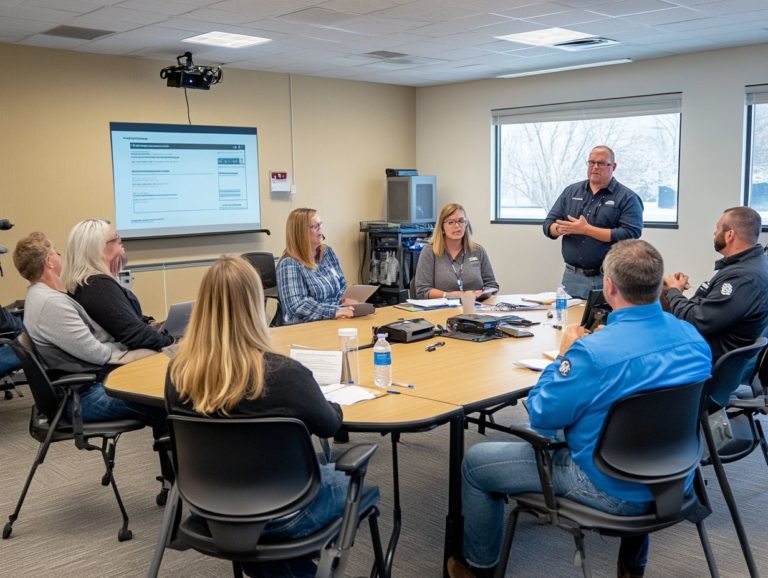incident response planning for small businesses
In today s digital landscape, small businesses like yours encounter a myriad of threats that can disrupt operations and tarnish your reputation.
Grasping the nuances of incident response planning is crucial for skillfully navigating these challenges. This article dissects the essentials of crafting a robust incident response plan specifically designed for small businesses.
You ll explore key components, from defining roles and establishing communication protocols to a detailed step-by-step guide for implementation. We equip you with the essential tools and knowledge to protect your business and respond adeptly when incidents arise.
We also highlight the importance of regular testing. This ensures your plan stays current and effective.
Dive in and get started now to protect your business from unexpected threats!
Contents
Key Takeaways:

Incident response planning is a crucial part of protecting small businesses from cyber attacks and other security incidents. Understanding the role of incident response in business continuity helps in establishing key components of a plan, including clearly defined roles, communication protocols, and risk assessment procedures. Regular testing and updating of the plan is essential to ensure its effectiveness in a real incident situation.
Understanding Incident Response Planning
Understanding Incident Response Planning (IRP) is essential for any organization aiming to safeguard its IT infrastructure against potential cyber threats, including risks like hacking or data theft, data breaches, and malware attacks.
An effective incident response plan clearly explains the steps and actions necessary for managing security incidents, enabling you to respond swiftly and effectively to mitigate risks and minimize damage.
This process involves assembling an incident response team (IRT), a group that manages security incidents, capable of assessing incidents, executing containment measures, and documenting evidence while adhering to established communication protocols.
By prioritizing IRP, you position your organization to navigate the complexities of cybersecurity with confidence and resilience.
What is Incident Response Planning?
Incident response planning is your structured game plan for preparing, detecting, responding to, and recovering from cybersecurity incidents or breaches. This proactive approach includes key elements that ensure you’re not just equipped to handle potential threats but also capable of minimizing the impact of any incidents that might arise.
A robust incident response policy is your foundation, detailing the roles, responsibilities, and expectations for every team member involved. Having documented processes acts as a roadmap that guides your response team during an incident, allowing for swift and efficient actions.
Establishing a clear strategy is essential; it enables quick decision-making and fosters communication among all stakeholders. This way, you ensure that all security protocols and incident documentation are followed, ultimately enhancing your organization’s resilience against the ever-evolving landscape of cyber threats.
Why is it Important for Small Businesses?
For small businesses, having an incident response plan is not merely a luxury; it is an essential component of your strategy. This plan equips you to handle security incidents effectively and minimizes the impact of potential data breaches or cyber threats.
In a landscape where a striking 43% of cyberattacks are aimed at small businesses, it s crucial for you to understand the unique challenges that come with cybersecurity. Many small businesses operate with limited resources and lack comprehensive security measures, making them prime targets for devastating breaches.
Without adequate risk management strategies, the consequences can be dire. In fact, 60% of small enterprises face closure within six months following a cyberattack. This alarming statistic highlights the urgent need for you to prioritize cybersecurity preparedness and customize your incident response plan to address your specific vulnerabilities.
Key Components of an Incident Response Plan

An effective Incident Response Plan (IRP) comprises several key components that seamlessly integrate to facilitate a swift and organized response to cybersecurity incidents.
Among these elements, you ll find clearly defined roles and responsibilities, comprehensive communication protocols, and thorough risk assessments, all designed to ensure your organization is well-prepared to tackle any challenge that arises.
Roles and Responsibilities
Within your incident response plan, each member of the incident response team (IRT) plays a crucial role. They ensure the effective management and resolution of security incidents.
As the team leader, you ll orchestrate the overall strategy. You will coordinate various actions during a security breach.
Data analysts will carefully look at information to identify the nature and scope of the incident. Other key personnel, such as experts who analyze data to understand what happened, will lend their expertise.
This technical insight is essential for implementing precise containment measures. A well-defined incident response checklist serves as a critical tool for guiding your team through systematic incident management.
This checklist includes vital security protocols and damage control procedures. It ensures that nothing slips through the cracks and that each incident is managed with the utmost efficiency.
Communication Protocols
Effective communication protocols are essential in your incident response plan. They ensure that information is conveyed accurately among team members, stakeholders, and occasionally legal representatives during a cybersecurity incident.
Clear communication is essential, especially in time-sensitive scenarios. Swift decision-making can significantly mitigate damage.
You should implement various protocols, including structured reporting methods for escalating significant issues. This ensures that the right people are informed promptly.
The incident response policy serves as a foundational guide for these communications. It underscores the importance of evidence preservation and reflects on lessons learned.
This structured approach not only streamlines information flow but also enhances collaboration. It enables everyone involved to respond more effectively while minimizing the risk of further complications.
Identifying and Assessing Risks
Act now to identify threats and protect your organization. Identifying and assessing risks is an essential step in your incident response planning.
You can conduct a risk assessment effectively by recognizing potential threats and gauging their severity. This guides your response strategy.
You’ll likely employ various methodologies and tools tailored to your specific environment. Techniques like SWOT analysis, a method to identify strengths, weaknesses, opportunities, and threats, are instrumental in pinpointing weaknesses and potential threats.
Utilizing automated threat detection tools can further enhance your visibility into security vulnerabilities and emerging risks. This comprehensive evaluation shapes your incident response plan.
It ensures that all aspects of incident documentation and recovery plans are well-coordinated. This approach not only fortifies your incident management strategy but also prepares you to tackle future challenges with confidence.
Creating an Incident Response Plan

Building a strong incident response plan is all about following clear steps. You need to clearly delineate procedures, assign responsibilities, and identify the necessary resources to address cybersecurity incidents effectively.
By following this structured framework, you position yourself to respond with precision and confidence in the face of potential threats.
Step-by-Step Guide
Creating an incident response plan involves several critical stages. These guide you from identifying the scope and objectives to outlining documented processes for tackling various types of incidents.
- In the initial phase, conduct a thorough risk assessment to comprehend the potential threats and vulnerabilities unique to your environment.
- Engage relevant stakeholders, bringing in teams from IT, legal, and communications for a well-rounded approach.
- Each team member must clearly understand their roles and responsibilities during an incident, which significantly aids in mitigating impacts effectively.
- Document processes for training and future reference, including security protocols for incident classification. This enables a structured response to specific scenarios.
This not only enhances preparedness but also builds resilience within your organization. Start building your plan today to safeguard your business against cyber threats!
Testing and Updating Your Plan
Regularly testing and updating your incident response plan is crucial. This keeps your team prepared for any situation.
This proactive approach helps your organization adapt to changing cyber threats.
Importance of Regular Testing and Updating
Regular testing and updates enhance your response capabilities. Learning from past incidents helps you improve.
This ongoing process is vital for effective recovery from threats. It ensures your plans evolve to meet new challenges.
By analyzing the severity of incidents, you can identify gaps in your protocols. Then, you can create strategies to address these gaps.
Learning from past experiences helps refine your procedures. This boosts efficiency when the unexpected happens.
It fosters a culture of preparedness, equipping your team to respond quickly and effectively. This minimizes potential disruptions and losses.
Dealing with an Incident

To manage an incident, implement clear response procedures. This helps limit damage and supports a swift recovery.
Steps to Take During and After an Incident
During and after an online security problem, follow the steps outlined in your response plan. This ensures effective management and recovery.
As soon as an incident occurs, your team must act quickly. They should classify the incident, assess its impact, and implement steps to limit harm.
An incident response checklist helps you handle these challenges. Once immediate actions are taken, a strong recovery plan is essential for restoring affected systems.
Regular training and evaluations help you continuously improve your strategies. This builds a more resilient security posture for the future.
Resources for Small Businesses
As a small business owner, you have access to many resources. These can equip you with tools and support for effective incident response planning.
Leveraging these resources prepares you to handle online security issues. This ensures your business stays resilient against potential threats.
Tools and Support for Incident Response Planning
You have powerful tools at your fingertips to build an effective incident response plan! Let s dive into these essential resources.
Incident management platforms are crucial. They help track incidents and facilitate communication for timely responses.
Risk assessment tools allow you to identify risks, while documentation software streamlines the creation of your response plans.
Training drills are vital, enabling your teams to practice their strategies and refine communication protocols. Engaging external consultants brings valuable expertise, offering objective assessments and advanced strategies that enhance your incident preparedness.
Frequently Asked Questions
What is incident response planning for small businesses?
Incident response planning for small businesses involves preparing and coordinating a response to potential security incidents like cyber attacks or natural disasters. It includes identifying risks, establishing protocols, and utilizing incident response planning templates you can use to develop a recovery plan.
Why is incident response planning important for small businesses?
Incident response planning is essential for small businesses as it minimizes the impact of security incidents. A quick and efficient response saves time, money, and protects your reputation. For an effective approach, consider strategic planning for incident response, which also demonstrates a commitment to safeguarding sensitive information and maintaining customer trust.
How can a small business create an incident response plan?
To create an incident response plan, first identify potential risks such as cyber attacks or human error. Establish roles and responsibilities, set up communication protocols, and develop contingency plans. Regularly review and update the plan to adapt to changing threats and technology.
What are some key components of an incident response plan?
Key components include an incident response team with defined roles, clear communication protocols, a detailed response procedure, and regular testing to ensure readiness. Include a business continuity and disaster recovery plan to minimize operational impacts.
How can a small business ensure effective incident response?
To ensure effective incident response, regularly test and update your plan. Provide training for employees on their roles and establish partnerships with cybersecurity experts. Don t skip a communication plan; it s vital for swift action during incidents!
What are some common challenges for small businesses in incident response planning?
Common challenges include limited resources, lack of cybersecurity expertise, and finding time to update the plan. Prioritizing incident response planning and seeking outside support can help overcome these hurdles and protect your business.
Start crafting your incident response plan today to protect your business from unexpected threats! Prepare now to safeguard your business against the unexpected!






